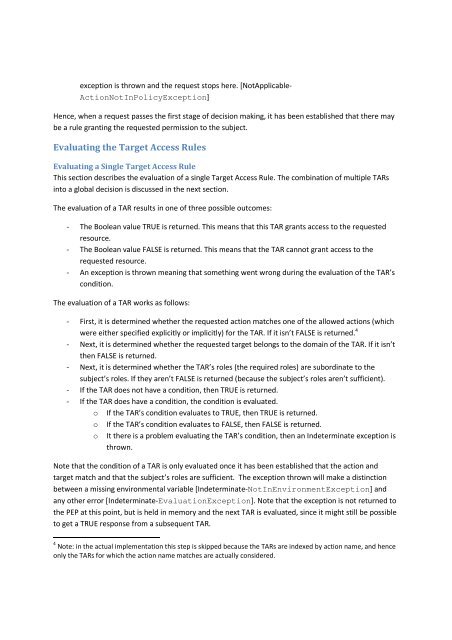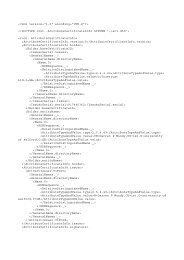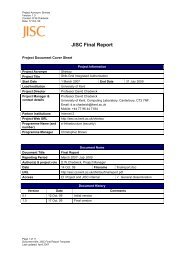Decision Making in PERMIS
Decision Making in PERMIS
Decision Making in PERMIS
You also want an ePaper? Increase the reach of your titles
YUMPU automatically turns print PDFs into web optimized ePapers that Google loves.
exception is thrown and the request stops here. [NotApplicable-<br />
ActionNotInPolicyException]<br />
Hence, when a request passes the first stage of decision mak<strong>in</strong>g, it has been established that there may<br />
be a rule grant<strong>in</strong>g the requested permission to the subject.<br />
Evaluat<strong>in</strong>g the Target Access Rules<br />
Evaluat<strong>in</strong>g a S<strong>in</strong>gle Target Access Rule<br />
This section describes the evaluation of a s<strong>in</strong>gle Target Access Rule. The comb<strong>in</strong>ation of multiple TARs<br />
<strong>in</strong>to a global decision is discussed <strong>in</strong> the next section.<br />
The evaluation of a TAR results <strong>in</strong> one of three possible outcomes:<br />
- The Boolean value TRUE is returned. This means that this TAR grants access to the requested<br />
resource.<br />
- The Boolean value FALSE is returned. This means that the TAR cannot grant access to the<br />
requested resource.<br />
- An exception is thrown mean<strong>in</strong>g that someth<strong>in</strong>g went wrong dur<strong>in</strong>g the evaluation of the TAR’s<br />
condition.<br />
The evaluation of a TAR works as follows:<br />
- First, it is determ<strong>in</strong>ed whether the requested action matches one of the allowed actions (which<br />
were either specified explicitly or implicitly) for the TAR. If it isn’t FALSE is returned. 4<br />
- Next, it is determ<strong>in</strong>ed whether the requested target belongs to the doma<strong>in</strong> of the TAR. If it isn’t<br />
then FALSE is returned.<br />
- Next, it is determ<strong>in</strong>ed whether the TAR’s roles (the required roles) are subord<strong>in</strong>ate to the<br />
subject’s roles. If they aren’t FALSE is returned (because the subject’s roles aren’t sufficient).<br />
- If the TAR does not have a condition, then TRUE is returned.<br />
- If the TAR does have a condition, the condition is evaluated.<br />
o If the TAR’s condition evaluates to TRUE, then TRUE is returned.<br />
o If the TAR’s condition evaluates to FALSE, then FALSE is returned.<br />
o It there is a problem evaluat<strong>in</strong>g the TAR’s condition, then an Indeterm<strong>in</strong>ate exception is<br />
thrown.<br />
Note that the condition of a TAR is only evaluated once it has been established that the action and<br />
target match and that the subject’s roles are sufficient. The exception thrown will make a dist<strong>in</strong>ction<br />
between a miss<strong>in</strong>g environmental variable [Indeterm<strong>in</strong>ate-NotInEnvironmentException] and<br />
any other error [Indeterm<strong>in</strong>ate-EvaluationException]. Note that the exception is not returned to<br />
the PEP at this po<strong>in</strong>t, but is held <strong>in</strong> memory and the next TAR is evaluated, s<strong>in</strong>ce it might still be possible<br />
to get a TRUE response from a subsequent TAR.<br />
4 Note: <strong>in</strong> the actual implementation this step is skipped because the TARs are <strong>in</strong>dexed by action name, and hence<br />
only the TARs for which the action name matches are actually considered.



 "
>
"
>


